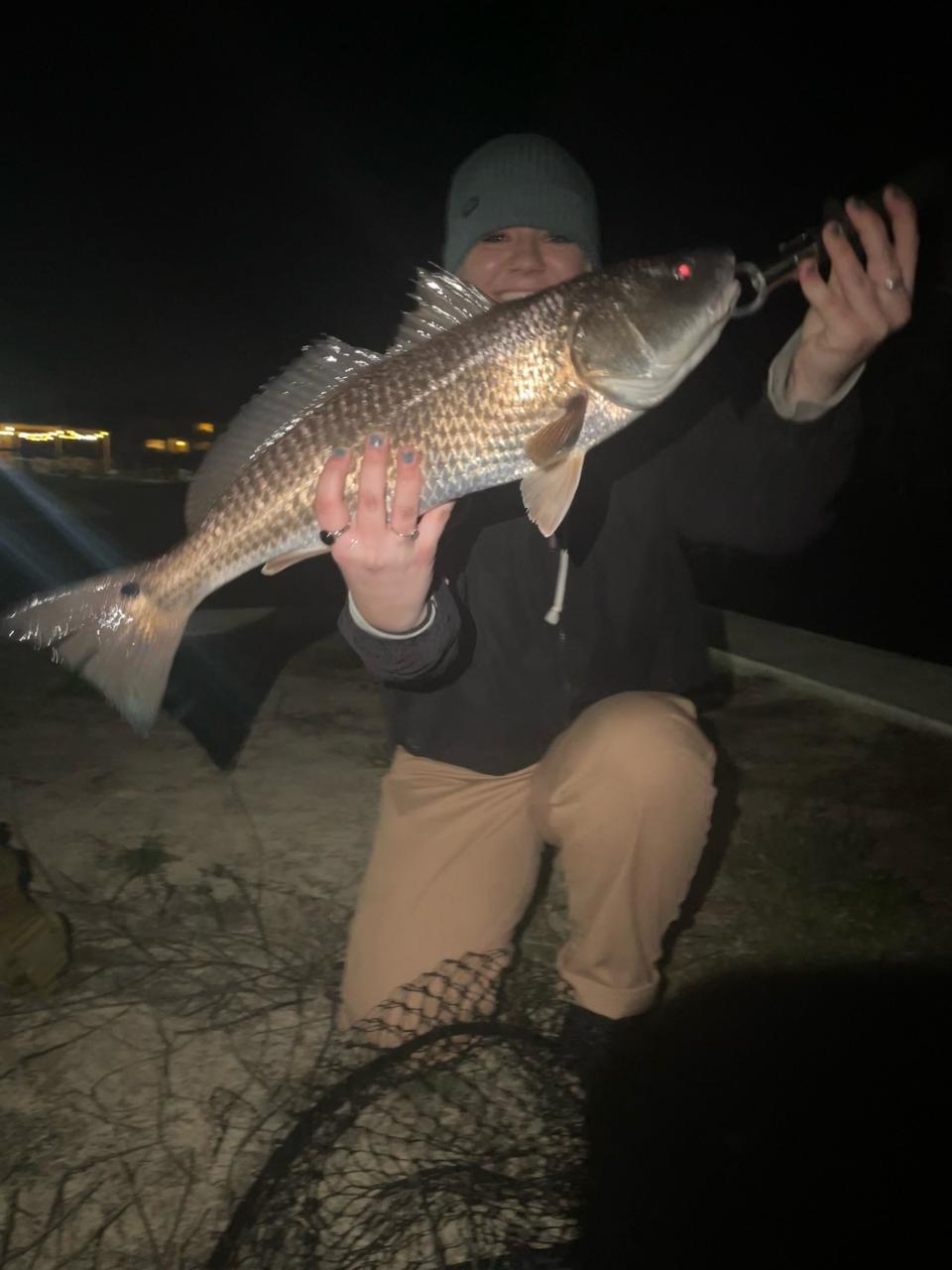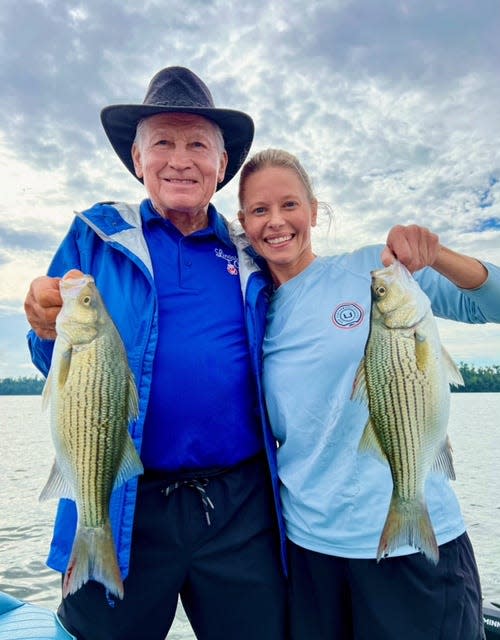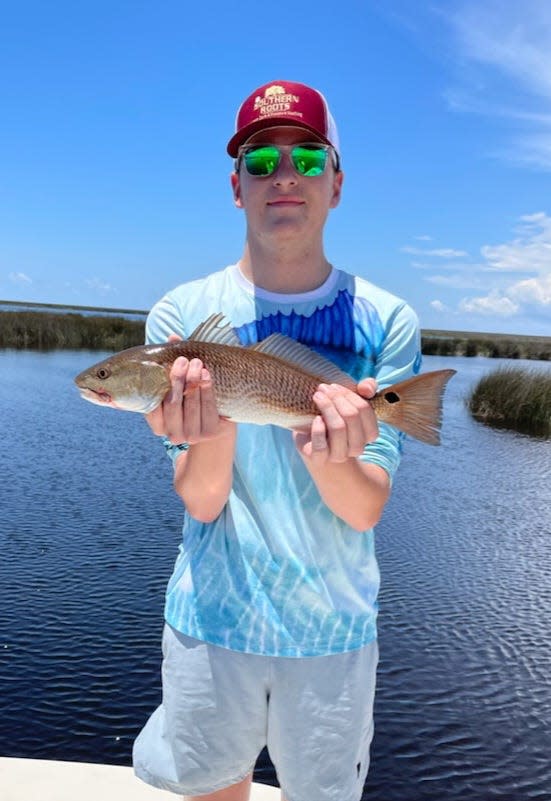Happy Fishing! Check out this weekend's Big Bend fishing report

With recent rainfall topping the several inch mark, hopes of Lake Jackson’s return loom large in the bass fishing community. But alas, it’s just another tease for the Jackson faithful.
Lake Jackson sits on Tallahassee's northwest side. During a normal season, lake Jackson holds roughly 4,000 acres of water for thousands of fishermen, boaters and hunters.
Severe drought conditions in 2019, followed by another sub-par 2020 of rain falling in the Tallahassee region, has dropped lake levels to some of the lowest in history for this extended period of time.
The low in 2019 was also a record with only 39.05 inches of rain. Next closest is 1921, with rainfall totals of 39.20” respectively. Average yearly rainfall hovers in the high 50’s. 1885 is the first known official record.
Lake Jackson is widely known for it’s ability to disappear, reappear, and offer up some of the biggest largemouth bass in the South East. Where those big fish go during a “dry down” is still a huge mystery.
Rain is key to keeping water levels consistent on Leon County’s prairie lake. There’s no river, creek or spring. Constant growth created no more run-off, or run-into. Evaporation is #1 reason for Lake Jackson water loss each year.
Local divers Blake Wilson and Steve Cox recently mapped miles of underwater caves in neighboring Wakulla county. Findings conclude, the Florida aquifer along with many springs interconnect through a series of underground rivers. This has long been theorized but until now, not proven.
Lake Jackson sits on what experts compare to a “Honeycomb” bottom. Limestone and sand is anything but stable. Add the Florida Aquifer flowing underneath, combined with low water levels and boom! Sink hole city.
Florida is blessed to be home to the most natural springs than any other state. More than 8 billion gallons flow from these springs each day at a constant temperature of 72 degrees. Because of this, companies like Nestle and 50 other water bottling company’s call this home.
Nestle, the world’s largest food company, has been granted permission from Florida to take more than 1 million gallons of water a day out of a spring to sell back to the public.
The cost paid to the state for rights to the water: a one-time application fee of $115.00. Just this week, the Suwannee River Water Management District Governing Board approved a permit application from Seven Springs Water company that will help Nestle expand its bottled-water operations in Gilchrist County.
Nestlé Waters North America, an affiliate of Swiss multinational Nestlé SA, is accustomed to extracting spring water in Florida, where the company and its partners are already permitted to take more than 3 million gallons a day from four groundwater sources: Crystal Springs in Zephyrhills, Cypress Springs in Vernon, Madison Blue Spring in Lee and White Springs in Bristol.
Conclusion: Over the years I’ve researched, met with biologists, done television shows, spent countless hours fishing, boating and wrote many an article on this famed waterway. It’s never been more evident that local growth, parlayed with farming of Florida Spring water has created this negative impact on this wonderful local resource. It’s unfortunate for future generations.
Cliff “JR” Mundinger

APALACHEE BAY
Otto Hough (Facebook @myhometownfishing) says, ”This past weekend, those pronounced new moon negative low tides that occurred in the morning hours limited early access to some good fishing holes for most folks, though that was not the case for the kayakers. Some my "yak fleet" fishing buddies had good luck early, both Friday and Saturday catching quality reds along with some fine mustard mouth trout. Unfortunately, Mother Nature messed up fishing this past Sunday as well as Wednesday with quite a bit of rain along stout winds that accompanied the strong frontal boundaries that passed over Apalachee Bay.
If the current marine weather forecast rings true going into the angling weekend ahead, there are likely going to be some cold starts at sunrise long about the same time high tides will be occurring along the Big Bend coastline. Unfortunately, it appears Friday and Saturday might be the only two good chances to wet a line before lingering all day showers show up Sunday morning. Given the cold nights, any sliver of warmth gained during this past week in the skinny water will have been erased by nighttime radiational cooling, pushing water temps back into the mid-50s. However, the cold nighttime temps will serve to keep lots of trout and reds up all the Big Bend rivers.
As such, expect to find those trout and reds, but especially the trout holed up in most of the deep river and creek holes at the start of the morning as they seek out a degree or two of warmth. A lot of trout and reds are hanging well above the power plant at St. Marks. There's an early morning major feed tracking the last few hours of the rising tides each day. Work those deep spots with a lively shrimp offering tipped on a jighead or on a Carolina rig; or, if going the artificial route, try a Z-man TRD on a Finesse BulletZ head. It's a great little NED setup to work in deep spots that might have a little vegetation or bottom clutter. When that tide finally turns after lunchtime, take a moment or two to target a creek mouth drain or two while plug casting, either with 17MR MirroDine or Rip-n-Slash 70, both are well liked by the trout and reds.
Outside, even though gag grouper is closed till September, the countless hundreds of rock piles lining the shallow (12' to 20') waters from St. Marks eastward well beyond the Aucilla are currently home to lots a bowhead rock bass, aka black sea bass. Fun, tasty fish to catch on light spinning tackle. Super for the kids or grandkids. A light 1/2 or 3/4 ounce tipped with a small piece of squid or a Gulp! or Z-man shrimp in pearl or white with a chartreuse tail will garner attention of the rock bass. My preferred technique is to slow drift over a rock formation while working a jig slowly. If the rock bass are on the rock, the bite should happen quickly. Should there be no takers, ease on to another pile to repeat the jigging technique. This time of year, slow trolling a small Rapala CDMag14 will catch a good number of bigger bowheads. Remember, the gags are also on many of those piles. With it being a closed season for the gags, take care to safely release any gags that might be caught as they are in their spawning mode.
Again, there's going to be a couple of cold fishing mornings, so layer up well. It's far easier to shed layers than shiver wishing you had worn another layer of insulation to start. Additionally, wear an auto-inflatable PFD and always be cognizant of the dangers presented by hypothermia this time of year. Boat both safely and wisely. Just FISH!

ST GEORGE ISLAND
Captain Russ Knapp (850-653-5072) reports, “The latest cold front to pass dropped 2.5 " of rain on us and had peak wins at 33 MPH. All things considered it wasn't to bad. Weather forecast for the weekend isn't to bad either for once with Saturday being sunny with a high of 60 degrees and seas running around 2 ft thanks to a 10-15 knot NE breeze.
On Sunday, the forecast calls for SE winds at 10 to 15 knots with seas of 2 to 3 feet and a chance of rain increasing during the day to 60 percent. Look for a high tide of 1 foot at the Cut around 9 AM followed by a 1 PM low of 0.8 feet closing out with a 1.5 high at 7 PM on Saturday. Sunday features one of those somewhat rare one tide per day deals with a 3:40 AM low tide at - 0.1 feet and the only high tide running 1.6 feet at 7 PM. As always, things change fast so be sure to recheck the forecast before you head out.
The fish in the bay have enjoyed a quiet, safe week as almost nobody has been out fishing for them given the weather and the lack of angler tourists this time of year. The few anglers that did get out reported Reds and Sheepshead around the Cut with the Sheepshead also to be found around the bridge pilings.
Capt. Dan Fortunas (850 980 0101) suggests stop by your friendly local bait and tackle shop and pick some frozen Finger Mullet for the Reds and some Fiddler Crabs or fresh Shrimp for the Sheepshead. Capt. Dan has had good results with cutting the Finger Mullet on a diagonal line which gets more scent into the water, while peeling the Shrimp makes them more interesting to the Sheepshead.
I really have no idea what to say about the river mouths and creeks in East Bay but given that we had 2.5 " of rain today I would think they are pretty full of fresh water.
Offshore, Capt. Clint Taylor (850 370 6631) says live bottom is your best bet with Mangrove Snapper close in 40 to 50ft of water while Red Grouper will be out in the 100ft range. Large live baits are the ticket for the Grouper while half Spanish Sardines will bring the Mangroves to your hook.
Tip of the week -- Now is the time to get your boat into the shop for any needed maintenance and repairs. Waiting for Spring is only going to get you at the end of even longer lines.
MEXICO BEACH
Captain Kevin Lanier of KC Sportfishing charters (850 933 8804) reports,” January is solidly upon and so far, it has been one of the coldest we have seen in several years here in the Florida Panhandle. As always happens this time of year we are dodging cold fronts and wind but there is some good fishing going on right now.
Inshore the larger Red Fish are back with the bites coming off the jetty and sea walls. Look for these fish on the flats because the water will warm there faster. Live Shrimp fish with just a small split shot weight or fished below a popping cork are your best options. Always keep a gold spoon close by to help entice the bite as well. Do not be surprised if a large Trout crushes the bait as well.
Offshore is money when you can get out. Plenty of Vermillion Snapper to eat and plenty of Red Snapper to release. I encourage you not to fish live baits this time of year due to the large amount of Red Snapper around. Jigs or squid will fill a fish box for sure.
This pattern will continue until early march so, if you can stand the cold weather you should catch plenty of fish.

BIG BEND KAYAK REPORT
Salt strong coach Matt Lanier (Matt@saltstrong.com) tells us, “I hope everyone is ready for some decent weather this weekend after the downpour we got this week! The cold temps and strong winds were tough this past week, making it a bit difficult to get on the water, but Sunday offered a chance for some of us.
With the cooler temps we will have after this rain, the fish will should feed pretty well if you find the right spot. The 10% of the water where 90% of the fish are at is known as the 90/10 zone. Finding this zone is super important this time of year! Typically, finding wind protection will be important, as the calmer areas will typically have warmer water.
The trout that are schooled up, are still found in their usual haunts around structure and ledges and depth changes. This past weekend they were found in the deeper holes in creeks, and on the ledges of the flats. Be sure to use jig heads heavy enough to get you down in the deeper part of the water column, where those fish are. Now that we are in the colder part of the year, exposed jig heads will be optimal, as there is less grass to get hung up in.
It can often be helpful to downsize the size of your bait in the colder months, going to a smaller presentation, to entice the bite from those more lethargic fish. The fish have a slower metabolism in the winter and will not use calories to chase a bait down like they will in the warmer months. Therefore, fishing smaller baits, on the bottom, is a great wintertime tactic.
With the warming trend, redfish can still be found roaming the flats in some of those late fall habits, cruising in creek mouths and oyster beds during the rising tide, and in the soft current seams of depth changes on the falling tide.
Productive lures range have been ranging from paddletails to shrimp imitations and hard baits (like the FRED Paddletail, Power Prawn, or the MR17), but the biggest factor is warmth. It the sun is shining, your lure choice can be a bit more aggressive and you can fish faster, but if it is a dark and cloudy day, try to go something smaller, and more subtle to illicit those strikes from fish that are slower to react.The Florida Redfish Series Season Opener is this Saturday, Jan. 28, in Stienhatchee at the Sea Hag Marina. Captains Meeting will be held Friday evening before the event at Sea Hag Marina, and both boaters and kayakers have a division! This will be a great event to start off the Florida Redfish Series for 2023, and I’m looking forward to seeing everyone there at the Captains Meeting and the weigh in! Be sure to go to flredfishseries.com for more information on this event and others upcoming.
If you find yourself on the water and fishing in a spot where you haven’t gotten a bite for the last 15 minutes… it’s time to move. Keep looking for the 90/10 zone where those fish are holding. Don’t waste time in unproductive areas. The fish are moving and so should you!
To get the kids on some fish quickly, a live shrimp or GULP! under a popping cork around creeks, creek mouths, and even grass lines is a solid producer of fish. And the best part is you never know what you’ll catch because everything eats shrimp… EVEN ME!For an easy way to find the 90/10 zone, go to www.saltstrong.com/recipe for some tips on finding the fish in your area!
If you plan on getting out this weekend, always make sure you check (and double check) your gear and the weather. But most importantly… STAY SAFE & HAVE FUN!
LAKE SEMINOLE
The Bass fishing on Lake Seminole has been excellent to start the new year!
As we close out January and move into February the Bass will transition into their pre spawn areas and the big Bass will be feeding up for the upcoming spawn!
Crappie fishing has also been very good this month and we been catching BIG ones as we move into February the Crappie fishing will get even better!
For an exciting Lake Seminole Fishing Adventure for Bass and or Crappie, email us @lakeseminolefishingadventures@gmail.com or follow us on Instagram @capt.paultyrefishing and Facebook @capt.paultyrefishing
Photo: She’s at it again. Local angler London Bush, did a little night fishing a couple weekends ago. Chilly temperatures were no match for her as she holds up another beautiful redfish.
This article originally appeared on Tallahassee Democrat: This weekend's Big Bend fishing report

